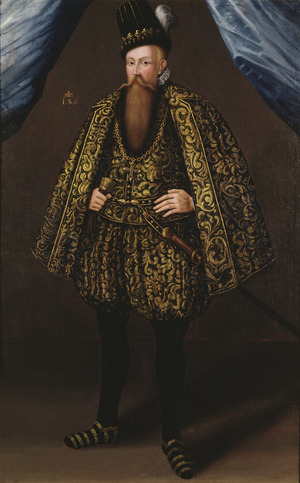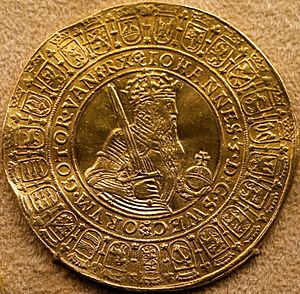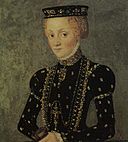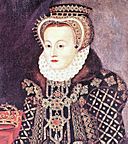John III of Sweden facts for kids
Quick facts for kids John III |
|
|---|---|

Portrait by Johan Baptista van Uther, 1582
|
|
| King of Sweden Grand Duke of Finland |
|
| Reign | January 1569 – 17 November 1592 |
| Coronation | 10 July 1569 |
| Predecessor | Eric XIV |
| Successor | Sigismund |
| Born | 20 December 1537 Stegeborg Castle |
| Died | 17 November 1592 (aged 54) Tre Kronor castle |
| Burial | 1 February 1594 Uppsala Cathedral |
| Spouse |
|
| Issue | Sigismund III, King of Poland and Sweden Anna, Starosta of Brodnica and Golub John, Duke of Östergötland Sophia, Baroness de la Gardie (ill.) Lucretia Gyllenhielm (ill.) |
| House | Vasa |
| Father | Gustav I of Sweden |
| Mother | Margaret Leijonhufvud |
| Religion | mediating between Lutheranism and Catholicism |
| Signature | |

John III (Swedish: Johan III, Finnish: Juhana III; 20 December 1537 – 17 November 1592) was the King of Sweden from 1569 until his death. He was the son of King Gustav I of Sweden and his second wife Margaret Leijonhufvud.
Before becoming king, he was the ruler of Finland as Duke John from 1556 to 1563. In 1581, he also took the title Grand Prince of Finland. He became king after a rebellion against his half-brother Eric XIV. John III is remembered for trying to bring together the new Lutheran Church of Sweden and the Catholic Church. He also had a difficult relationship with his brother, which led to his brother's death.
His first wife was Catherine Jagellonica from the Polish-Lithuanian royal family. Their son Sigismund later became king of both Poland-Lithuania and Sweden.
Contents
Early Life and Rise to Power
John was the second son of Gustav Vasa, who ruled from 1523 to 1560. His mother was Margaret Leijonhufvud, a Swedish noblewoman. King Gustav sent John to Finland to protect Swedish lands in the eastern Baltic Sea from Russia.
John was also sent to England to try and arrange a marriage between his half-brother, Crown Prince Erik, and Queen Elizabeth I. This marriage would have helped Sweden connect with Western Europe. The mission did not succeed. However, in England, John saw how Protestantism was being brought back. He became very interested in church services and religious ideas.
Conflict with Eric XIV
As the Duke of Finland, John disagreed with his half-brother, King Eric XIV (1560–1569). Eric wanted to control important ports in the East Baltic, like Reval. Because of these disagreements, John and his wife, Katarina, were put in prison at Gripsholm Castle in 1563.
After being released from prison, likely because his brother was having mental health issues, John joined other nobles who wanted to remove Eric from the throne. John then became king himself. His important ally was his uncle, Sten Leijonhufvud. Soon after, John had Eric's most trusted advisor, Jöran Persson, executed. John blamed Persson for his harsh treatment in prison.
Foreign Policy and Wars
King John III started peace talks with Denmark-Norway and Lübeck to end the Scandinavian Seven Years' War. However, he did not accept the peace terms his envoys agreed to in the Treaties of Roskilde (1568). After two more years of fighting, the war ended with the Treaty of Stettin (1570), which was more favorable to Sweden.
In the years that followed, he successfully fought Russia in the Livonian War. This war ended with the Treaty of Plussa in 1583. It meant that Sweden took back the city of Narva. John's foreign policy was also shaped by his connection to Poland, as his son Sigismund III Vasa became king of Poland in 1587.
Religious Views and Architecture
In Sweden, John showed some support for the Catholic faith. This was partly influenced by his Polish wife. This caused some tension with the Swedish clergy and nobles. He tried to get help from the Pope to get back his wife's family money, which was frozen in Naples. He also allowed Jesuits to secretly work at the Royal Theological College in Stockholm.
John himself was a learned follower of the theologian George Cassander. He tried to find a way for Rome (Catholicism) and Wittenberg (Lutheranism) to agree. In 1571, John approved the publication of the Lutheran Swedish Church Order. But in 1575, he added a new part to it, called Nova ordinantia ecclesiastica, which brought back some older church practices. This led to his famous Red Book, which brought back several Catholic customs. This caused a long-lasting Liturgical Struggle in Sweden.
In 1575, he allowed the remaining Catholic convents in Sweden to accept new members again. He often disagreed on religious matters with his younger brother, Duke Charles. John III was also a great supporter of art and architecture. He transformed the medieval Kalmar Castle into a beautiful Renaissance palace. He often lived there because it was closer to Poland.
John III as King
In January 1569, John was recognized as king by the Riksdag of the Estates, which is like a parliament. This was the same group that had removed Eric XIV from the throne. John made sure that his brother Karl's dukedom was confirmed without the old restrictions. The power and rights of the nobles were also increased.
John was worried about his position as king as long as Eric was alive. While Eric was imprisoned, there were three main plots to remove John from the throne. These were the 1569 Plot, the Mornay Plot, and the 1576 Plot. John was so afraid that Eric might be freed that in 1571, he ordered the guards to kill Eric if there was any attempt to free him. It is possible that this is how Eric died in 1577.
John III claimed that he had freed Sweden from the "tyrant" Eric XIV. He compared this to how his father had freed Sweden from the "bloodhound" Christian II. John was known to be a strong-willed, quick-tempered, and very suspicious person.
Family Life
John married his first wife, Catherine Jagellonica of Poland (1526–83), in Vilnius on 4 October 1562. She was from the Jagiellonian royal family and was the sister of King Sigismund II Augustus of Poland. Their children were:
- Isabella (1564–1566)
- Sigismund (1566–1632), who became King of Poland (1587–1632) and King of Sweden (1592–99). He was also Grand Duke of Finland and Lithuania.
- Anna (1568–1625)
He married his second wife, Gunilla Bielke (1568–1592), on 21 February 1585. They had one son:

- John (1589–1618), who was first Duke of Finland and then Duke of Ostrogothia from 1608. This young duke married his cousin Maria Elisabet (1596–1618), who was the daughter of Charles IX of Sweden.
John also had at least four children with his mistress, Karin Hansdotter (1532–1596):
- Sofia Gyllenhielm (1556–1583), who married Pontus De la Gardie.
- Augustus Gyllenhielm (1557–1560)
- Julius Gyllenhielm (1559–1581)
- Lucretia Gyllenhielm (1560–1585)
John continued to care for Karin and their children even after he married Catherine Jagellonica in 1562. He arranged for Karin to marry a nobleman, Klas Andersson, who was a friend and servant. They had a daughter named Brita. John continued to support Karin and his illegitimate children when he became king in 1568. In 1572, Karin married again to Lars Henrikson, whom John made a nobleman in 1576 to help care for his children with Karin. In the same year, he made his daughter Sofia a lady in the castle, serving his sister Princess Elizabeth of Sweden. In 1580, John arranged for Sofia to marry Pontus de la Gardie. She later died while giving birth to Jacob De la Gardie.
See also
 In Spanish: Juan III de Suecia para niños
In Spanish: Juan III de Suecia para niños





